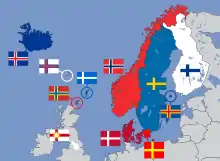علم الصليب الشمالي
يصف مصطلح علم صليب الشمال الأعلام والرايات التي تحمل تصميم ما يسمى الصليب الشمالي أو الإسكندنافي، حيث يمثل العلم رمز الصليب في حقل مستطيل. أقدم هذه الأعلام كان علم الدنمارك.

مجموعة مختارة من أعلام الصليب الشمالي المستخدم في دول شمال أوروبا، من اليسار إلى اليمين
الصف العلوي: آيسلندا، جزر فارو، جزر أوركني، جزر شتلاند، النرويج، السويد، جزر أولاند، فنلندا;
الصف السفلي: الدنمارك، سكانيا.
الصف العلوي: آيسلندا، جزر فارو، جزر أوركني، جزر شتلاند، النرويج، السويد، جزر أولاند، فنلندا;
الصف السفلي: الدنمارك، سكانيا.
وقد اعتمدت كل من بلدان دول الشمال هذه الأعلام في العصر الحديث، وكثيرًا ما يدعى أيضًا علم الصليب الإسكندنافي لإستخدام الدول الإسكندنافية الصليب الشمالي في أعلامها الوطنية.[1] يرمز الصليب إلى الصليب المسيحي، ويستمد العلم تصميمه من تصاميم تعود للقرن الثالث عشر أثناء الحروب الصليبية.[2][3][4]
مراجع
- EnchantedLearning.com; Historical flags of the world: The scandinavian cross; Eric Inglefield: "Fahnen und Flaggen" (translated to German by Dagmar Hahn), Delphin Verlag, Munich 1986, p.16 "نسخة مؤرشفة". Archived from the original on 3 ديسمبر 2017. اطلع عليه بتاريخ 17 مارس 2016. الوسيط
|CitationClass=تم تجاهله (مساعدة)صيانة CS1: BOT: original-url status unknown (link) - Jeroen Temperman. State Religion Relationships and Human Rights Law: Towards a Right to Religiously Neutral Governance. Martinus Nijhoff Publishers. صفحة 88. مؤرشف من الأصل في 17 يناير 2020. اطلع عليه بتاريخ 31 ديسمبر 2007.
Many predominantly Christian states show a cross, symbolising Christainity, on their national flag. The so-called Scandinavian crosses or Nordic crosses on the flags of the Nordic countries–Denmark, Finland, Iceland, Norway and Sweden–also represent Christianity.
الوسيط|CitationClass=تم تجاهله (مساعدة) نسخة محفوظة 28 مايو 2016 على موقع واي باك مشين. - Carol A. Foley. The Australian Flag: Colonial Relic or Contemporary Icon. William Gaunt & Sons. مؤرشف من الأصل في 5 يوليو 2014. اطلع عليه بتاريخ 31 ديسمبر 2007.
The Christian cross, for instance, is one of the oldest and most widely used symbols in the world, and many European countries, such as the United Kingdom, Norway, Sweden, Finland, Denmark, Iceland, Greece and Switzerland, adopted and currently retain the Christian cross on their national flags.
الوسيط|CitationClass=تم تجاهله (مساعدة) - Andrew Evans. Iceland. Bradt. مؤرشف من الأصل في 10 سبتمبر 2014. اطلع عليه بتاريخ 31 ديسمبر 2007.
Legend states that a red cloth with the white cross simply fell from the sky in the middle of the 13th-century Battle of Valdemar, after which the Danes were victorious. As a badge of divine right, Denmark flew its cross in the other Scandinavian countries it ruled and as each nation gained independence, they incorporated the Christian symbol.
الوسيط|CitationClass=تم تجاهله (مساعدة)
مواقع خارجية
انظر أيضًا
في كومنز صور وملفات عن: علم الصليب الشمالي
- بوابة آيسلندا
- بوابة أوروبا
- بوابة الدنمارك
- بوابة السويد
- بوابة المسيحية
- بوابة النرويج
- بوابة ثقافة
- بوابة جرينلاند
- بوابة جزر فارو
- بوابة علم الشعارات
- بوابة فنلندا
- بوابة فنون
This article is issued from Wikipedia. The text is licensed under Creative Commons - Attribution - Sharealike. Additional terms may apply for the media files.
